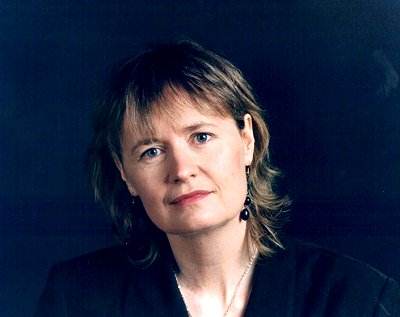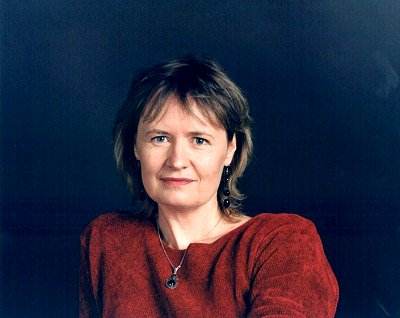Sally
Beamish Interviewed by Christopher Thomas
2004

Despite
the apparent suddenness of Sally Beamish’s
arrival on the musical scene around
fifteen years ago composition has been
a part of her life since childhood.
An early career as a professional viola
player followed studies at the Royal
Northern College of Music and led to
work with numerous ensembles, several
of whom, such as Lontano and the London
Sinfonietta, provided opportunities
to work closely with new music.
It was
at the end of the 1980s that two events
came together, resulting in her taking
the decision to concentrate on composition.
The first was the theft of her viola,
the second a move to Scotland that was
to have an immediate impact on her work.
A steady flow of commissions followed
and her catalogue has grown at an impressive
rate to encompass every major genre
including opera, orchestral (there are
two symphonies to date), chamber, scores
for television and radio, choral music
and a number of pieces for non-professional
performers, an area in which she has
a keen interest.
Several
high profile commissions have been instrumental
in placing Beamish’s name before a wider
public. Notable amongst these are her
2001 Proms commission, the oratorio
Knotgrass Elegy and a further
work heard at the Proms in 2003, the
Trumpet Concerto written for
Håkan Hardenberger. There have
also been concertos for several other
prominent musicians including a Violin
Concerto for Anthony Marwood, two
concertos for her own instrument, the
viola, a Cello Concerto for Robert
Cohen and The Imagined Sound of Sun
on Stone, for saxophonist John Harle.
This latter work has been recorded on
the BIS label as have several others
of her works (see reviews on Musicweb).
Three discs have been issued so far
with plans for further recordings on
the same label.
In recent
years Sally Beamish has participated
in a joint composer in residency scheme
with the Scottish and Swedish chamber
orchestras, a post shared with Swedish
composer Karin Rehnqvist. This has generated
four major commissions over a four-year
period. Current projects include an
orchestral score commissioned by BBC
Scotland for the television series "Writing
Scotland" as well as a Double
Concerto for clarinettist Michael
Collins and violinist Isabelle van Keulen
and a Flute Concerto for Sharon
Bezaly. The coming months will see the
premiere of a Percussion Concerto
for Evelyn Glennie and a tango based
work, Takes Two, for accordionist
James Crabb and cellist Robert Irvine.
A complete
list of Sally Beamish’s works can be
found on her web pages at the Scottish
Music Centre www.scottishmusiccentre.com

CT
Were you exposed to music very early
in life?
SB
Yes, my mother is a violinist and my
father an amateur flautist. His family
are very musical and there was a lot
of singing and chamber music in the
house.
CT
At what age did you start to play the
viola and compose?
SB
My mother taught me to read and
write music when I was 4, and that was
when I started composing. I began piano
at 5 and violin at 9, changing to viola
when I was 15 (and joining the NYO),
but returning to violin for my first
year at the Royal Northern College of
Music.
CT
You have stated on numerous occasions
that you consider yourself first and
foremost a composer rather than a violist.
Was this a conscious decision and if
so when was it made?
SB
I always knew composing was my true
means of expression and I always intended
to play the viola as a means to support
myself while composing. But after studying
viola with Bruno Giuranna in Germany
I became much more interested in the
viola and started doing very stimulating
work, including the Raphael Ensemble,
Academy of St Martins, and most importantly
London Sinfonietta and Lontano, which
was where I learnt a lot of compositional
skill. But it became harder and harder
to devote time to composition and in
the end I had to make a definite decision
and cut right back on playing. This
was made easier by the fact that the
viola on generous loan to me was stolen
in 1989.
CT
What and whom were the principal musical
influences on you during your formative
years and musical education?
SB
My father worked for Philips record
company and used to bring back records
for technical checks. I would listen
to some of these over and over again
– in particular Malcolm Arnold’s Tam
O' Shanter, and the Walton Viola Concerto
played by Primrose. My mother played
in an early production of Peter Grimes
at Sadler’s Wells and took me along
to rehearsals. When I was 15 I was introduced
to Lennox Berkeley, who gave me enormous
encouragement right into my twenties.
CT
During your early years as a professional
violist what do you feel you were able
to draw from your experiences of playing
with ensembles such as Lontano and the
London Sinfonietta?
SB
Some of the music was conducted by the
composer, so I was working with people
like Oliver Knussen and Berio, both
of whom agreed to look at my scores.
Knussen gave me a series of lessons
on train journeys between concerts and
these were the only regular tuition
I ever had. I also learnt what it means
to play a new piece of music and how
important it is that the material is
well prepared and well written for the
instruments.
CT
You have said that your decision to
concentrate on composition came about
as a result of your viola being stolen.
At the time did you feel that fate was
playing a part here?
SB
I decided to put it down to fate. I
knew I had to start composing seriously,
and this seemed to be a good moment.
I was shattered by the loss of the viola
and I wanted to make something good
come of it.
CT
Stylistically, your music can cover
a remarkably wide range with elements
of jazz, folk and world music all rubbing
shoulders with your "classical"
voice. Has this integration been a naturally
evolving process for you?
SB
I have always been rather a ‘sponge’
when it comes to outside influences
and this includes all kinds of music
as well as art, film and literature.
I started to paint in 1992 and this
was very enriching for my composing.
In 2002 I also started to write seriously
and I am now beginning to incorporate
my own texts into my music.
CT
How do works usually start for you and
what is your process of composition?
SB
My works nearly always start with a
commission, so to some extent the form
and content is dictated. I often enjoy
a close working relationship with the
player for whom I’m writing, and sometimes
they might even suggest an idea for
the piece, as in the case of Anthony
Marwood, who suggested I base his violin
concerto on Remarque’s novel ‘All Quiet
on the Western Front’.
I start
with a plan, in words, like a programme
note, then invent the themes and chord
structures I need for it. Once I have
this outline, I can start to ‘colour’,
and that’s where the creative bit really
starts.
CT
Following your move to Scotland in 1989
did you feel that your new surroundings
had an immediate impact on your music?
SB
Culturally I immediately found Scotland
very stimulating – there is a strong
sense of heritage in the arts, and this
is linked to the incredible surroundings,
and the feeling of community and mutual
support. And there are far more opportunities
in a small country – one is immediately
more ‘visible’.
CT
Are there any particular works that
you consider to be pivotal in your output?
SB
Certainly ‘No, I’m not Afraid’
(1989), which was my first large-scale
work (for narrator, strings, oboe and
harp). That piece gave me the confidence
to become much more ambitious in my
forms and structures. I continue to
use words as a starting point for many
of my pieces, even if they are not spoken
or sung – sometimes they simply serve
as a template. And then the Violin
Concerto (1995), which marked a
freeing up of my harmonic style. I had
a lesson with Birtwistle on this piece,
which was a life-changing experience.
CT In what way was
it life changing?
SB Birtwistle
opened my eyes to the possibilities
of layering in orchestration - before
that I had been quite conservative and
cautious. Since that lesson I have taken
a more dramatic approach to orchestration,
creating energy and tension by using
instrumental colour and more adventurous
rhythms.
CT
Your Prom commission Knotgrass Elegy
raised the question of environmental
issues. Have such issues always been
a preoccupation for you?
SB
Yes, but it was Graham Harvey’s book
‘The Killing of the Countryside’ that
moved me to build an oratorio on the
theme. In the book he tells the powerful
story of a humble weed, whose destruction
sets off a chain of loss, causing untold
damage. I then commissioned a text from
poet Donald Saunders, which is a kind
of modern-day parable.
CT
Amongst other composers whom do you
particularly admire?
SB
Amongst living composers, I think the
ones that have influenced me most have
been Mark Anthony Turnage and Oliver
Knussen. But I admire lots of others
too.
CT
Given that you lead a busy life as a
mother as well as a composer do you
have to discipline yourself to particular
work patterns?
SB
Yes, when the children were small I
booked a babysitter for 4 hours every
morning. That was a good discipline.
In fact I find it harder to be focused
now that I have more time and I’m not
paying anyone!
CT
How would you succinctly sum your music
up?
SB
I think it is pictorial, but also based
on established forms. It is always tonal,
but sometimes dissonant in an expressionistic
kind of way. There is a lot of jazz
and a lot of Celtic influence. Eclectic?
CT
Looking to the future, are there any
works that you have a burning desire
to write given the right opportunity?
SB
I’d love to write a ballet.
Christopher
Thomas

